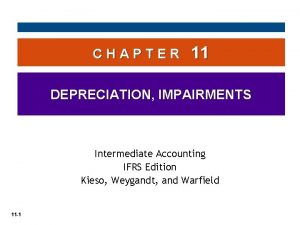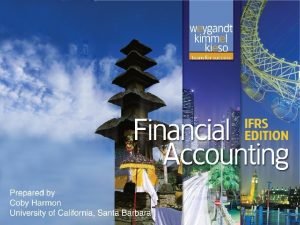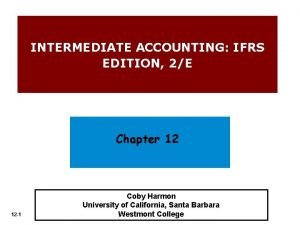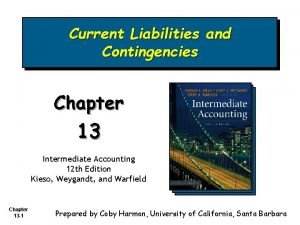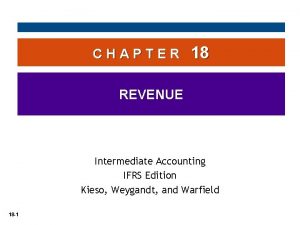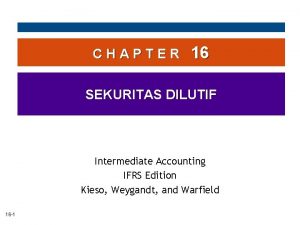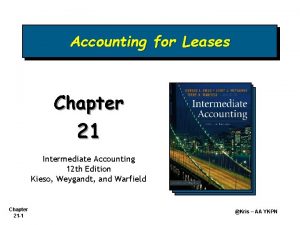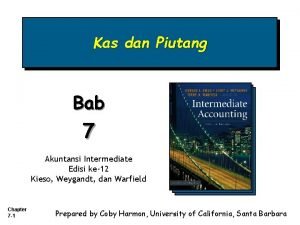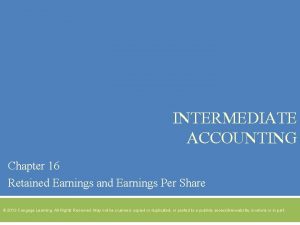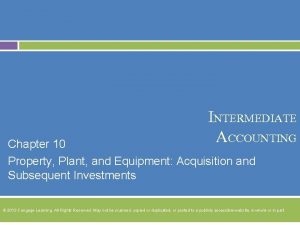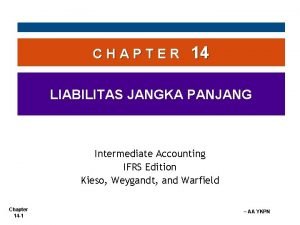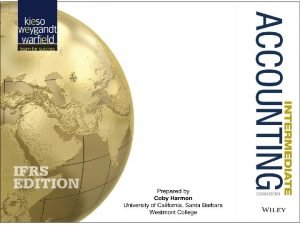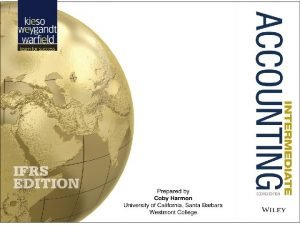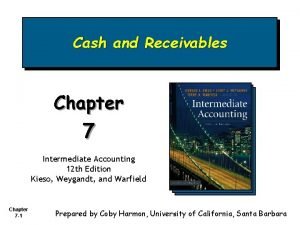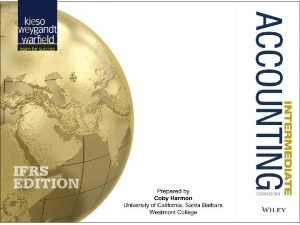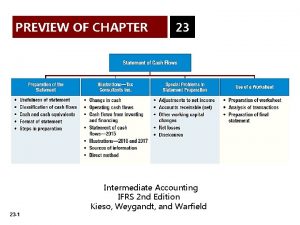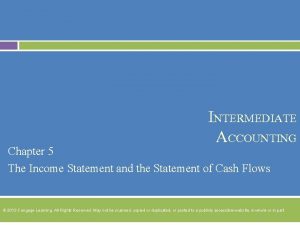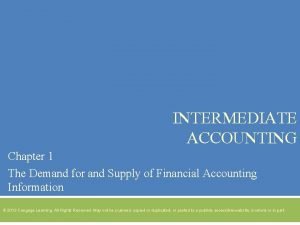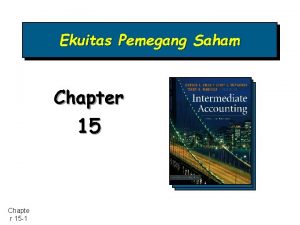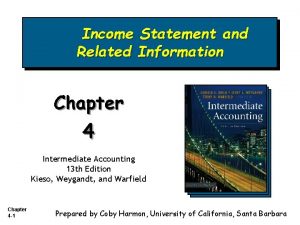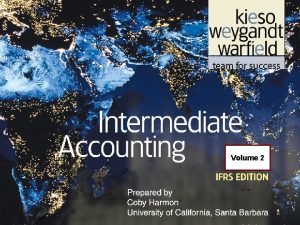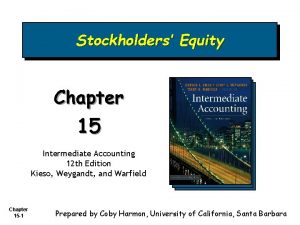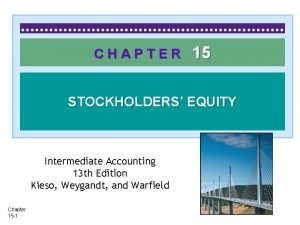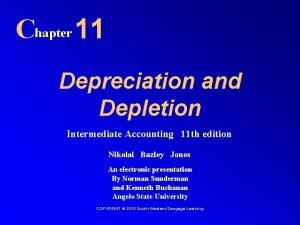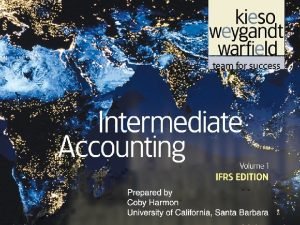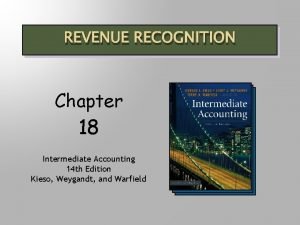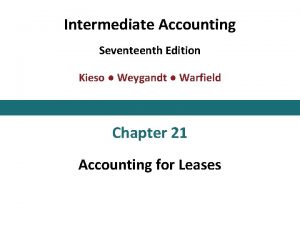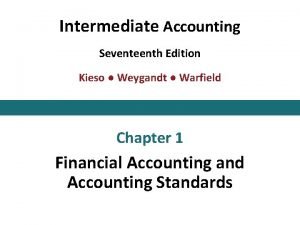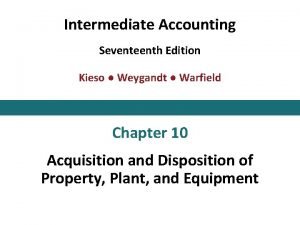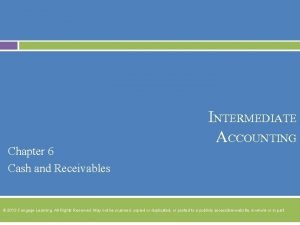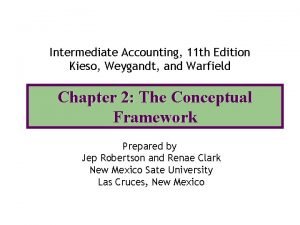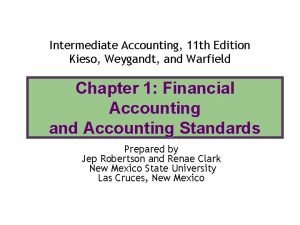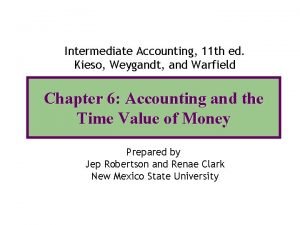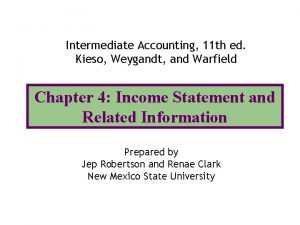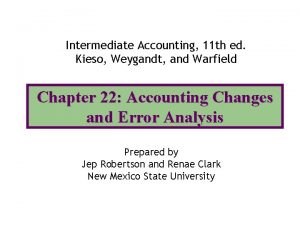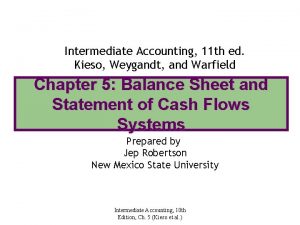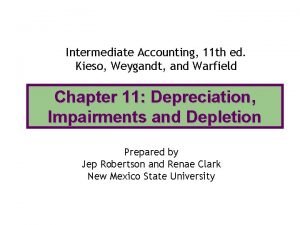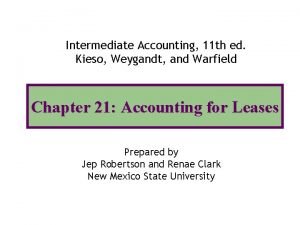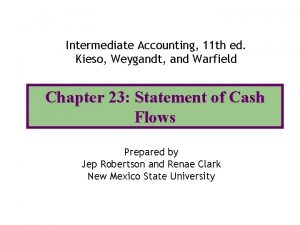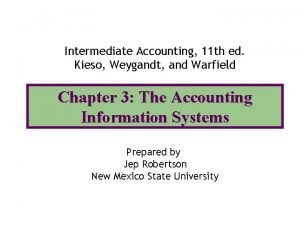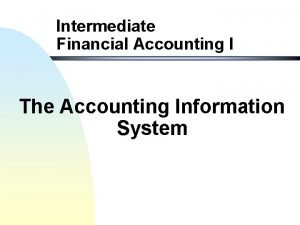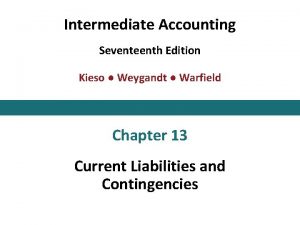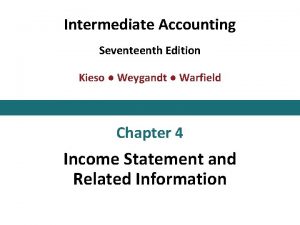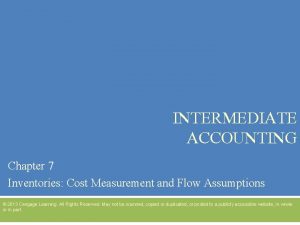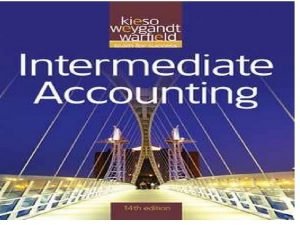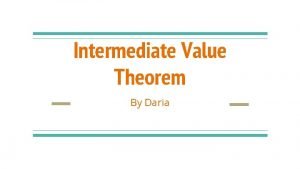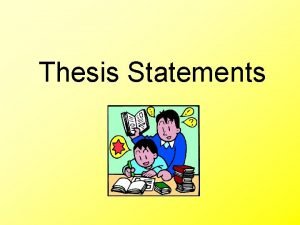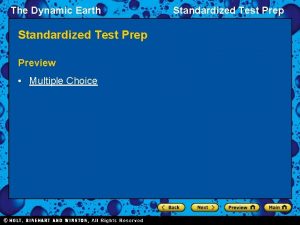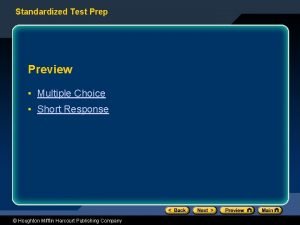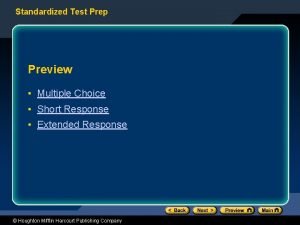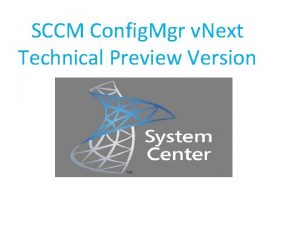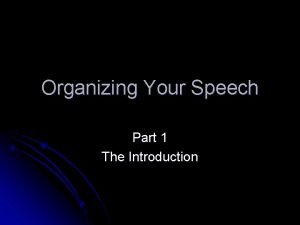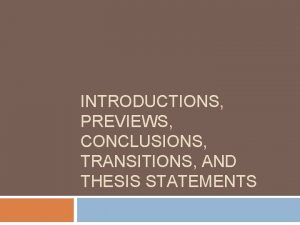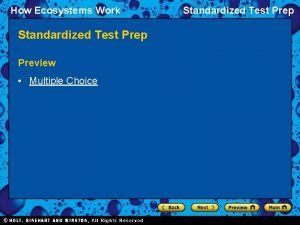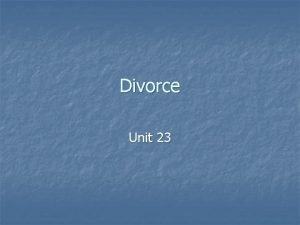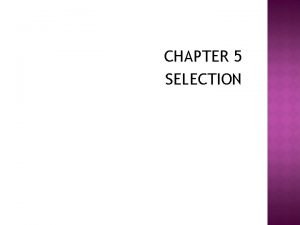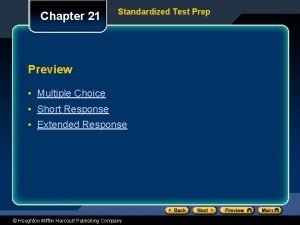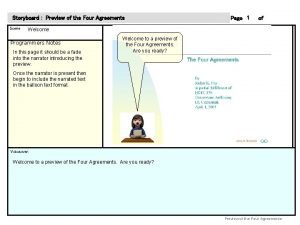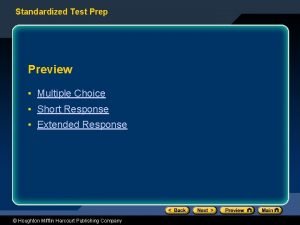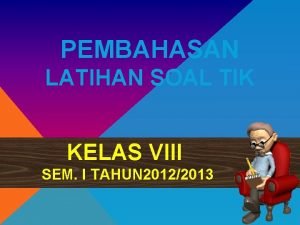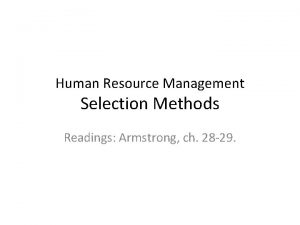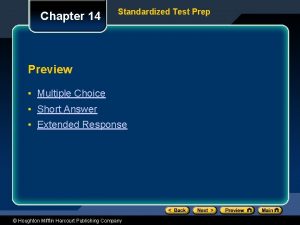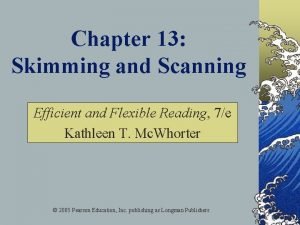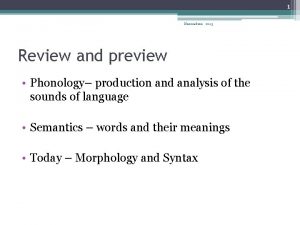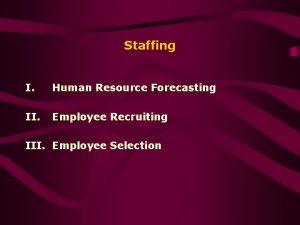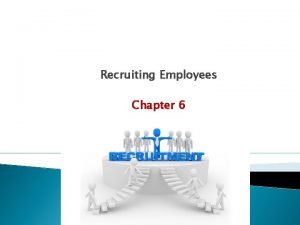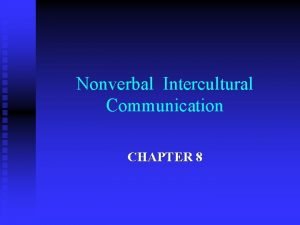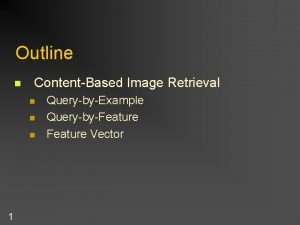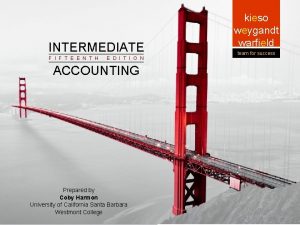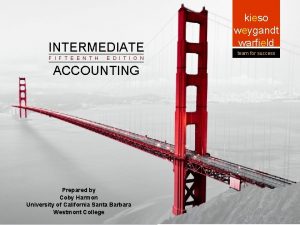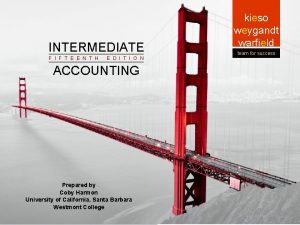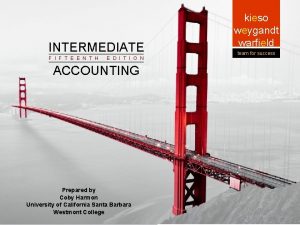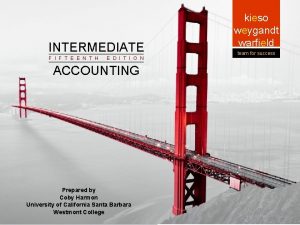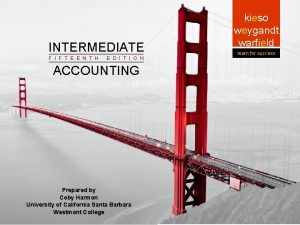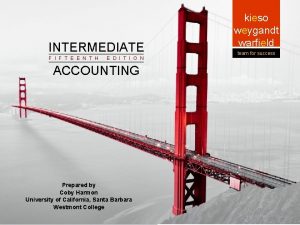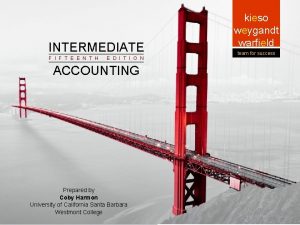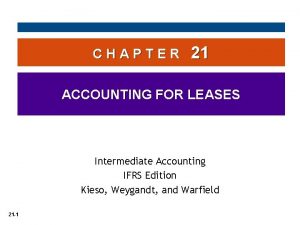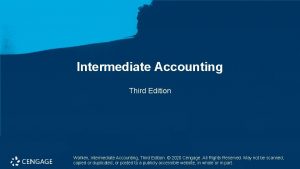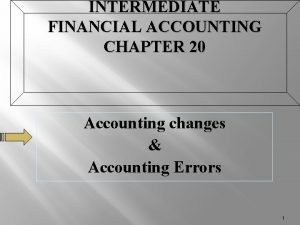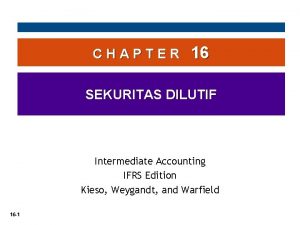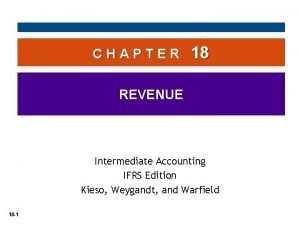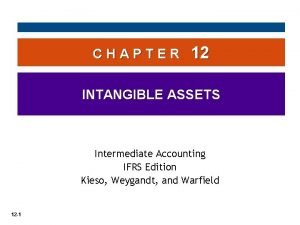PREVIEW OF CHAPTER 23 Intermediate Accounting IFRS 2
























































































- Slides: 88

PREVIEW OF CHAPTER 23 Intermediate Accounting IFRS 2 nd Edition Kieso, Weygandt, and Warfield 23 -1

23 Statement of Cash Flows LEARNING OBJECTIVES After studying this chapter, you should be able to: 6. Identify sources of information for a 1. Describe the purpose of the statement of cash flows. 2. Identify the major classifications of cash flows. 3. Prepare a statement of cash flows. 4. Differentiate between net income and net cash flow from operating activities. 5. Determine net cash flows from 23 -2 investing and financing activities. 7. Contrast the direct and indirect methods of calculating net cash flow from operating activities. 8. Discuss special problems in preparing a statement of cash flows. 9. Explain the use of a worksheet in preparing a statement of cash flows.

PREPARATION OF STATEMENT OF CASH FLOWS Primary purpose: To provide information about a company’s cash receipts and cash payments during a period. Secondary objective: To provide cash-basis information about the company’s operating, investing, and financing activities. 23 -3 LO 1

PREPARATION OF STATEMENT OF CASH FLOWS Usefulness of the Statement of Cash Flows Provides information to help assess: 1. Entity’s ability to generate future cash flows. 2. Entity’s ability to pay dividends and meet obligations. 3. Reasons for the difference between net income and net cash flow from operating activities. 4. Cash and noncash investing and financing transactions during the period. 23 -4 LO 1

23 Statement of Cash Flows LEARNING OBJECTIVES After studying this chapter, you should be able 1. to: Describe the purpose of the 6. Identify sources of information for a statement of cash flows. 2. Identify the major classifications of cash flows. 3. Prepare a statement of cash flows. 4. Differentiate between net income and net cash flow from operating activities. 5. Determine net cash flows from 23 -5 investing and financing activities. statement of cash flows. 7. Contrast the direct and indirect methods of calculating net cash flow from operating activities. 8. Discuss special problems in preparing a statement of cash flows. 9. Explain the use of a worksheet in preparing a statement of cash flows.

PREPARATION OF STATEMENT Classification of Cash Flows Operating Activities Investing Activities Financing Activities Income Changes in Investments and Non. Current Asset Items Changes in Equity and Non-Current Liability Items Statement Items 23 -6 LO 2

Classification of Cash Flows Income Statement Items ILLUSTRATION 23 -1 Classification of Typical Cash Inflows and Outflows 23 -7 LO 2

Classification of Cash Flows Generally Investments and Non. Current Asset Items Generally Equity and Non-Current Liability Items ILLUSTRATION 23 -1 Classification of Typical Cash Inflows and Outflows 23 -8 LO 2

Cash and Cash Equivalents The basis recommended by the IASB for the statement of cash flows is actually “cash and cash equivalents. ” Cash equivalents are short-term, highly liquid investments that are both: u Readily convertible to known amounts of cash, and So near their maturity that they present insignificant risk of changes value in (e. g. , due to changes in interest rates). Generally, only investments with original maturities of u three months or less qualify under this definition. 23 -9 LO 2

Product Life Cycle 23 -10

Format of the Statement of Cash Flows Presentation: 1. Operating activities. Direct Method 2. Investing activities. Indirect Method 3. Financing activities. Report inflows and outflows from investing and financing activities separately. 23 -11 LO 2

Format of the Statement of Cash Flows ILLUSTRATION 23 -2 23 -12 LO 2

Steps in Preparation Three Sources of Information: 1. Comparative statements of financial position. 2. Current income statement data. 3. Selected transaction data. Three Major Steps: Step 1. Determine change in cash. Step 2. Determine net cash flow from operating activities. Step 3. Determine net cash flows from investing and financing activities. 23 -13 LO 2

23 Statement of Cash Flows LEARNING OBJECTIVES After studying this chapter, you should be able 1. to: Describe the purpose of the 6. Identify sources of information for a statement of cash flows. 2. Identify the major classifications of cash flows. 3. Prepare a statement of cash flows. 4. Differentiate between net income and net cash flow from operating activities. 23 -14 5. Determine net cash flows from statement of cash flows. 7. Contrast the direct and indirect methods of calculating net cash flow from operating activities. 8. Discuss special problems in preparing a statement of cash flows. 9. Explain the use of a worksheet in preparing a statement of cash flows.

ILLUSTRATIONS— Tax Consultants Inc. Illustration: Tax Consultants Inc. started on January 1, 2015, when it issued 60, 000 shares of $1 par value common stock for $60, 000 cash. The company rented its office space, furniture, and equipment, and performed tax consulting services throughout the first year. The comparative statements of financial position at the beginning and end of the year 2015 appear in Illustration 23 -3. Illustration 23 -4 shows the income statement and additional information for Tax Consultants. 23 -15 LO 3

ILLUSTRATIONS— Tax Consultants Inc. ILLUSTRATION 23 -3 Comparative statements of financial position, Tax Consultants Inc. , Year 1 23 -16 LO 3

ILLUSTRATIONS— Tax Consultants Inc. ILLUSTRATION 23 -4 Income Statement, Tax Consultants Inc. , Year 1 23 -17 Additional Information: Examination of selected data indicates that a dividend of $14, 000 was declared and paid during the year. LO 3

ILLUSTRATIONS— Tax Consultants Inc. Step 1: Determine the Change in Cash ILLUSTRATION 23 -3 Comparative statements of financial position, Tax Consultants Inc. , Year 1 23 -18 LO 3

23 Statement of Cash Flows LEARNING OBJECTIVES After studying this chapter, you should be able 1. to: Describe the purpose of the 6. Identify sources of information for a statement of cash flows. 2. Identify the major classifications of cash flows. 3. Prepare a statement of cash flows. 4. Differentiate between net income and net cash flow from operating activities. 5. Determine net cash flows from investing and financing activities. 23 -19 statement of cash flows. 7. Contrast the direct and indirect methods of calculating net cash flow from operating activities. 8. Discuss special problems in preparing a statement of cash flows. 9. Explain the use of a worksheet in preparing a statement of cash flows.

ILLUSTRATIONS— Tax Consultants Inc. Step 2: Determine the Net Cash Flow from Operating Activities u Company must determine revenues and expenses on a cash basis. 23 -20 u Eliminate the effects of income statement transactions that do not result in an increase or decrease in cash. u Convert net income to net cash flow from operating activities through either a direct method or an indirect method. LO 4

ILLUSTRATIONS— Tax Consultants Inc. Step 2: Determine the Net Cash Flow from Operating Activities 23 -21 ILLUSTRATION 23 -5 Net Income versus Net Cash Flow from Operating Activities LO 4

ILLUSTRATIONS— Tax Consultants Increase in Accounts Receivable—Indirect Method Accounts receivable increased by $36, 000 (from $0 to $36, 000) during the year. Accounts Receivable 1/1/15 Balance 0 Revenues 125, 000 12/31/15 Balance ILLUSTRATION 23 -6 Receipts from customers 89, 000 36, 000 When the Accounts Receivable balance increases, cash receipts are lower than revenue earned under the accrual basis. 23 -22 LO 4

ILLUSTRATIONS— Tax Consultants Increase in Accounts Receivable—Indirect ILLUSTRATION 23 -6 Method Accounts Receivable 1/1/15 Balance 0 Revenues 125, 000 12/31/15 Balance Receipts from customers 89, 000 36, 000 The increase in accounts receivable is subtracted from net income to arrive at net cash provided by operating activities. ILLUSTRATION 23 -7 23 -23 LO 4

ILLUSTRATIONS— Tax Consultants Increase in Accounts Payable—Indirect Method Accounts payable increased by $5, 000 during the year. When accounts payable increase during the year, expenses on an accrual basis exceed those on a cash basis. ILLUSTRATION 23 -7 23 -24 LO 4

23 Statement of Cash Flows LEARNING OBJECTIVES After studying this chapter, you should be able 1. to: Describe the purpose of the 6. Identify sources of information for a statement of cash flows. 2. Identify the major classifications of cash flows. 3. Prepare a statement of cash flows. 4. Differentiate between net income and net cash flow from operating activities. 5. Determine net cash flows from 23 -25 investing and financing activities. statement of cash flows. 7. Contrast the direct and indirect methods of calculating net cash flow from operating activities. 8. Discuss special problems in preparing a statement of cash flows. 9. Explain the use of a worksheet in preparing a statement of cash flows.

Step 3: Determine Net Cash Flows from Investing and Financing Activities TAX CONSULTANTS INC. Statement Of Cash Flows For The Year Ended December 31, 2015 Increase (Decrease) In Cash ILLUSTRATION 23 -8 23 -26 ILLUSTRATION 23 -3

Step 3: Determine Net Cash Flows from Investing and Financing Activities TAX CONSULTANTS INC. Statement Of Cash Flows For The Year Ended December 31, 2015 Increase (Decrease) In Cash ILLUSTRATION 23 -8 23 -27 ILLUSTRATION 23 -3

Step 3: Determine Net Cash Flows from Investing and Financing Activities TAX CONSULTANTS INC. Statement Of Cash Flows For The Year Ended December 31, 2015 Increase (Decrease) In Cash ILLUSTRATION 23 -8 23 -28 ILLUSTRATION 23 -3

Step 3: Determine Net Cash Flows from Investing and Financing Activities TAX CONSULTANTS INC. Statement Of Cash Flows For The Year Ended December 31, 2015 Increase (Decrease) In Cash ILLUSTRATION 23 -8 23 -29 ILLUSTRATION 23 -3

Statement of Cash Flows— 2015 ILLUSTRATION 23 -8 23 -30

Illustration— 2016 23 -31 ILLUSTRATION 23 -9 Comparative Statements of Financial Position, Tax Consultants Inc. , Year 2 LO 5

Illustration— 2016 ILLUSTRATION 23 -10 Income Statement, Tax Consultants Inc. , Year 2 23 -32 LO 5

Step 1: Determine the Change in Cash ILLUSTRATION 23 -9 23 -33 LO 5

Step 2: Determine Net Cash Flow from Operating Activities—Indirect Method ILLUSTRATION 23 -9 23 -34 Accounts receivable decreased during the period because cash receipts (cash-basis revenues) are higher than revenues reported on an accrual basis. LO 5

Step 2: Determine Net Cash Flow from Operating Activities—Indirect Method To convert net income to net cash flow from operating activities, the decrease of $10, 000 in accounts receivable must be added to net income. ILLUSTRATION 23 -11 Computation of Net Cash Flow from Operating Activities, Year 2—Indirect Method 23 -35 LO 5

Step 2: Determine Net Cash Flow from Operating Activities—Indirect Method ILLUSTRATION 23 -9 23 -36 When prepaid expenses (assets) increase during a period, expenses on an accrual-basis income statement are lower than they are on a cash-basis income statement. LO 5

Step 2: Determine Net Cash Flow from Operating Activities—Indirect Method To convert net income to net cash flow from operating activities, the increase of $6, 000 must be deduct from net income. ILLUSTRATION 23 -11 Computation of Net Cash Flow from Operating Activities, Year 2—Indirect Method 23 -37 LO 5

Step 2: Determine Net Cash Flow from Operating Activities—Indirect Method ILLUSTRATION 23 -9 When accounts payable increase, the company incurred a greater amount of expense than the amount of cash it disbursed. 23 -38 LO 5

Step 2: Determine Net Cash Flow from Operating Activities—Indirect Method Tax Consultants must add the 2016 increase of $35, 000 in accounts payable to net income, to convert to net cash flow from operating activities. ILLUSTRATION 23 -11 Computation of Net Cash Flow from Operating Activities, Year 2—Indirect Method 23 -39 LO 5

Step 2: Determine Net Cash Flow from Operating Activities—Indirect Method ILLUSTRATION 23 -10 23 -9 Depreciation expense of $21, 000 (also represented by the increase in accumulated depreciation) is a non-cash charge. 23 -40 LO 5

Step 2: Determine Net Cash Flow from Operating Activities—Indirect Method Tax Consultants adds depreciation expense back to net income, to arrive at net cash flow from operating activities. ILLUSTRATION 23 -11 Computation of Net Cash Flow from Operating Activities, Year 2—Indirect Method 23 -41 LO 5

Step 3: Determine Net Cash Flow from Investing and Financing Activities ILLUSTRATION 23 -9 The company purchased land of $70, 000 during the period. 23 -42 LO 5

Step 3: Determine Net Cash Flow from Investing and Financing Activities The purchase of land for cash is an investing activity, reported as a use of cash. ILLUSTRATION 23 -12 Statement of Cash Flows, Tax Consultants Inc. , Year 2 23 -43 LO 5

Step 3: Determine Net Cash Flow from Investing and Financing Activities ILLUSTRATION 23 -9 Tax Consultants acquired an office building using $200, 000 cash. 23 -44 LO 5

Step 3: Determine Net Cash Flow from Investing and Financing Activities The purchase of a building for cash is an investing activity, reported as a use of cash. ILLUSTRATION 23 -12 Statement of Cash Flows, Tax Consultants Inc. , Year 2 23 -45 LO 5

Step 3: Determine Net Cash Flow from Investing and Financing Activities ILLUSTRATION 23 -9 Tax Consultants acquired equipment using $68, 000 cash. 23 -46 LO 5

Step 3: Determine Net Cash Flow from Investing and Financing Activities The purchase of equipment for cash is an investing activity, reported as a use of cash. ILLUSTRATION 23 -12 Statement of Cash Flows, Tax Consultants Inc. , Year 2 23 -47 LO 5

Step 3: Determine Net Cash Flow from Investing and Financing Activities ILLUSTRATION 23 -9 Tax Consultants acquired received $150, 000 from the issuance of bonds. 23 -48 LO 5

Step 3: Determine Net Cash Flow from Investing and Financing Activities The cash received from the issuance of these bonds represents an inflow of cash from a financing activity. ILLUSTRATION 23 -12 Statement of Cash Flows, Tax Consultants Inc. , Year 2 23 -49 LO 5

Step 3: Determine Net Cash Flow from Investing and Financing Activities ILLUSTRATION 23 -9 Two factors explain the increase in retained earnings: (1) net income of $134, 000 increased retained earnings, and (2) dividends of $18, 000 decreased retained earnings. 23 -50 LO 5

Step 3: Determine Net Cash Flow from Investing and Financing Activities Payment of the dividends is a financing activity that involves a cash outflow. ILLUSTRATION 23 -12 Statement of Cash Flows, Tax Consultants Inc. , Year 2 23 -51 LO 5

ILLUSTRATION 2312 23 -52 LO 5

23 Statement of Cash Flows LEARNING OBJECTIVES After studying this chapter, you should be able 1. to: Describe the purpose of the 6. Identify sources of information statement of cash flows. for a statement of cash flows. 2. Identify the major classifications of cash flows. 3. Prepare a statement of cash flows. 4. Differentiate between net income and net cash flow from operating activities. 5. Determine net cash flows from investing and financing activities. 23 -53 7. Contrast the direct and indirect methods of calculating net cash flow from operating activities. 8. Discuss special problems in preparing a statement of cash flows. 9. Explain the use of a worksheet in preparing a statement of cash flows.

Sources of Information for the Statement of Cash Flows 1. Comparative statements of financial position. 2. An analysis of the Retained Earnings account. 3. Write-downs, amortization charges, and similar “book” entries, such as depreciation, because they have no effect on cash. 23 -54 LO 6

Indirect Method—Additional Adjustments ILLUSTRATION 23 -17 Adjustments Needed to Determine Net Cash Flow from Operating Activities—Indirect Method 23 -55 LO 6

23 Statement of Cash Flows LEARNING OBJECTIVES After studying this chapter, you should be able 1. to: Describe the purpose of the 6. Identify sources of information for a statement of cash flows. 2. Identify the major classifications of cash flows. 3. Prepare a statement of cash flows. 4. Differentiate between net income and net cash flow from operating activities. 5. Determine net cash flows from investing and financing activities. 23 -56 statement of cash flows. 7. Contrast the direct and indirect methods of calculating net cash flow from operating activities. 8. Discuss special problems in preparing a statement of cash flows. 9. Explain the use of a worksheet in preparing a statement of cash flows.

Net Cash Flow from Operating Activities—Direct Method ILLUSTRATION 23 -21 Major Classes of Cash Receipts and Payments 23 -57 LO 7

Direct Method Example Drogba Company, which began business on January 1, 2015, has the following selected statement of financial position information. ILLUSTRATION 23 -19 Statement of Financial Position Accounts, Drogba Co. 23 -58 LO 7

Direct Method Example Drogba’s December 31, 2015, income statement and additional information are as follows. ILLUSTRATION 23 -20 Income Statement, Drogba Co. 23 -59 Additional Information (a) Dividends of € 70, 000 were declared and paid in cash. (b) The accounts payable increase resulted from the purchase of merchandise. (c) Prepaid expenses and accrued expenses payable relate to operating LO 7

Operating Activities — Direct Method Accounts receivable increased € 15, 000. Thus, cash receipts from customers are computed as follows. Illustration 23 -22 Accounts Receivable 1/1/15 Balance 59, 000 Sales revenue 780, 000 12/31/15 Balance 15, 000 23 -60 Receipts from customers 765, 000 LO 7

Operating Activities — Direct Method Drogba Company reported cost of goods sold on its income statement of € 450, 000. In 2015, Drogba Company’s inventory increased € 160, 000. The company computes purchases as follows. Cost of goods sold € 450, 000 Add: Increase in inventory 160, 000 Purchases € 610, 000 Accounts Payable 1/1/15 Purchases Balance 610, 000 12/31/15 Balance 23 -61 0 60, 000 LO 7

Operating Activities — Direct Method Drogba determines cash payments to suppliers by adjusting purchases for the change in accounts payable. Accounts Payable 1/1/15 Payments to suppliers 550, 000 Purchases Balance 0 610, 000 12/31/15 Balance 60, 000 ILLUSTRATION 23 -23 Formula to Compute Cash Payments to Suppliers 23 -62 LO 7

Operating Activities — Direct Method Drogba reported operating expenses of € 160, 000 on its income statement. To determine the cash paid for operating expenses, it must adjust this amount for any changes in u prepaid expenses and u accrued expenses payable. ILLUSTRATION 23 -24 Formula to Compute Cash Payments for Operating Expenses 23 -63 LO 7

Operating Activities — Direct Method Prepaid Expenses 1/1/15 Balance 12/31/15 Balance 0 8, 000 Accrued Expenses Payable 1/1/15 Balance 12/31/15 Balance Operating expenses Add: Increase in prepaid expenses Deduct: Increase in accrued expenses payable Cash payments for operating expenses 23 -64 0 20, 000 € 160, 000 8, 000 20, 000 € 148, 000 LO 7

Operating Activities — Direct Method The income statement for Drogba shows income tax expense of € 48, 000. Cash paid for income taxes is computed by taking the expense and adjusting by the change in the payable. Income Tax Payable 1/1/15 Payments for income tax 48, 000 23 -65 Balance 0 Income tax expense 48, 000 12/31/15 Balance 0 LO 7

Operating Activities — Direct Method Presentation of the direct method for reporting net cash flow from operating activities. ILLUSTRATION 23 -26 Operating Activities Section—Direct Method, 2016 23 -66 LO 7

Operating Activities — Direct Method When companies use the direct method they are required to provide in a separate schedule the reconciliation of net income to net cash provided by operating activities. ILLUSTRATION 23 -26 Operating Activities Section—Direct Method, 2016 23 -67 LO 7

Operating Activities — Direct Method A separate schedule reconciling net income to net cash provided by operating activities is required when using the direct method. 23 -68 ILLUSTRATION 23 -27 Reconciliation of Net Income to Net Cash Provided by Operating Activities, 2016 LO 7

23 Statement of Cash Flows LEARNING OBJECTIVES After studying this chapter, you should be able 1. to: Describe the purpose of the 6. Identify sources of information for a statement of cash flows. 2. Identify the major classifications of cash flows. 3. Prepare a statement of cash flows. 4. Differentiate between net income and net cash flow from operating activities. 5. Determine net cash flows from investing and financing activities. 23 -69 statement of cash flows. 7. Contrast the direct and indirect methods of calculating net cash flow from operating activities. 8. Discuss special problems in preparing a statement of cash flows. 9. Explain the use of a worksheet in preparing a statement of cash flows.

SPECIAL PROBLEMS IN STATEMENT PREPARATION Adjustments to Net Income Depreciation and Amortization u Amortization of limited-life intangible assets. u Amortization of bond discount or premium. Postretirement Benefit Costs u 23 -70 Company must adjust net income by the difference between cash paid and the expense reported. LO 8

Adjustments to Net Income Changes in Deferred Income Taxes u Affect net income but have no effect on cash. Equity Method of Accounting u Net increase in the investment account does not affect cash flows. u Company must deduct the net increase from net income to arrive at net cash flow from operating activities. 23 -71 LO 8

Adjustments to Net Income Loss and Gains u A loss is added to net income to compute net cash flow from operating activities because the loss is a noncash charge in the income statement. u Company reports a gain in the statement of cash flows as part of the cash proceeds from the sale of equipment under investing activities, thus it deducts the gain from net income to avoid doublecounting—once as part of net income and again as part of the cash proceeds from the sale. 23 -72 LO 8

Adjustments to Net Income Share-Based Compensation 23 -73 u Cash is not affected by recording the expense. u The company must increase net income by the amount of compensation expense from share options in computing net cash flow from operating activities. LO 8

SPECIAL PROBLEMS Accounts Receivable (Net) Indirect Method Because an increase in Allowance for Doubtful Accounts results from a charge to bad debt expense, a company should add back an increase in Allowance for Doubtful Accounts to net income to arrive at net cash flow from operating activities. 23 -74 ILLUSTRATION 23 -28 Accounts Receivable Balances, Redmark Co. LO 8

Accounts Receivable (Net) Indirect Method One method of presenting this information in the statement of cash flows: ILLUSTRATION 23 -29 Presentation of Allowance for Doubtful Accounts—Indirect Method REDMARK CO. Statement of Cash Flows (Partial) For The Year 2014 23 -75 LO 8

Accounts Receivable (Net) Indirect Method Alternate method (net approach) of presenting this information in the statement of cash flows: ILLUSTRATION 23 -30 Net Approach to Allowance for Doubtful Accounts—Indirect Method REDMARK CO. Statement of Cash Flows (Partial) For The Year 2014 23 -76 LO 8

Accounts Receivable (Net) Direct Method Company should not net Allowance for Doubtful Accounts against Accounts Receivable. 23 -77 ILLUSTRATION 2331 Income Statement, Redmark Co. LO 8

Accounts Receivable (Net) Direct Method ILLUSTRATION 23 -31 REDMARK CO. Income Statement For The Year 2014 Company should not net Allowance for Doubtful Accounts against Accounts Receivable. ILLUSTRATION 2332 Bad Debts—Direct Method Cash sales should be reported at € 85, 000 (€ 100, 000 - 9, 000 - 6, 000). 23 -78 Increase in Accounts Receivable LO 8

SPECIAL PROBLEMS Other Working Capital Changes Some changes in working capital, although they affect cash, do not affect net income. 23 -79 u Purchase of short-term non-trading equity securities. u Issuance of a short-term non-trade note payable for cash. u Cash dividend payable. LO 8

SPECIAL PROBLEMS Net Losses Illustration: If the net loss is £ 50, 000 and the total amount of charges to add back is £ 60, 000, then net cash provided by operating activities is £ 10, 000. ILLUSTRATION 23 -33 Computation of Net Cash Flow from Operating Activities—Cash Inflow 23 -80 LO 8

Disclosures Significant Non-Cash Transactions Common noncash transactions that a company should report or disclose: 1. Acquisition of assets by assuming liabilities (including finance lease obligations) or by issuing equity securities. 2. Exchanges of non-monetary assets. 3. Refinancing of long-term debt. 4. Conversion of debt or preference shares to ordinary shares. 5. Issuance of equity securities to retire debt. 23 -81 LO 8

23 Statement of Cash Flows LEARNING OBJECTIVES After studying this chapter, you should be able 1. to: Describe the purpose of the 6. Identify sources of information for a statement of cash flows. 2. Identify the major classifications of cash flows. 3. Prepare a statement of cash flows. 4. Differentiate between net income and net cash flow from operating activities. 5. Determine net cash flows from investing and financing activities. 23 -82 statement of cash flows. 7. Contrast the direct and indirect methods of calculating net cash flow from operating activities. 8. Discuss special problems in preparing a statement of cash flows. 9. Explain the use of a worksheet in preparing a statement of cash flows.

USE OF A WORKSHEET A worksheet involves the following steps. Step 1. Enter the statement of financial position accounts and their beginning and ending balances in the statement of financial position accounts section. Step 2. Enter the data that explain the changes in the statement of financial position accounts and their effects on the statement of cash flows in the reconciling columns of the worksheet. Step 3. Enter the increase or decrease in cash on the cash line and at the bottom of the worksheet. This entry should enable the totals of the reconciling columns to be in 23 -83 agreement. LO 9

GLOBAL ACCOUNTING INSIGHTS STATEMENT OF CASH FLOWS As in IFRS, the statement of cash flows is a required statement for U. S. GAAP. In addition, the content and presentation of a U. S. GAAP statement of cash flows is similar to one used for IFRS. However, the disclosure requirements related to the statement of cash flows are more extensive under U. S. GAAP. 23 -84

GLOBAL ACCOUNTING INSIGHTS Relevant Facts Following are the key similarities and differences between U. S. GAAP and IFRS related to the statement of cash flows. Similarities • Both U. S. GAAP and IFRS require that companies prepare a statement of cash flows. • Both U. S. GAAP and IFRS require that the statement of cash flows should have three major sections—operating, investing, and financing —along with changes in cash and cash equivalents. • Similar to U. S. GAAP, the cash flow statement can be prepared using either the indirect or direct method under IFRS. For both U. S. GAAP and IFRS, most companies use the indirect method for reporting net cash flow from operating activities. 23 -85

GLOBAL ACCOUNTING INSIGHTS Relevant Facts Similarities • The definition of cash equivalents used in U. S. GAAP is similar to that used in IFRS. Differences • Under U. S. GAAP, bank overdrafts are classified as financing activities. A major difference in the definition of cash and cash equivalents is that in certain situations, bank overdrafts are considered part of cash and cash equivalents under IFRS. 23 -86

GLOBAL ACCOUNTING INSIGHTS Relevant Facts Differences • Under U. S. GAAP, companies may present non-cash investing and financing activities in the cash flow statement. IFRS requires that noncash investing and financing activities be excluded from the statement of cash flows. As indicated in the chapter, these non-cash activities should be reported elsewhere. This requirement is interpreted to mean that non-cash investing and financing activities should be disclosed in the notes to the financial statements instead of in the financial statements. • One area where there can be substantive differences between U. S. GAAP and IFRS relates to the classification of interest, dividends, and taxes. U. S. GAAP requires that except for dividends paid (which are classified as a financing activity), these items are all reported as 23 -87

GLOBAL ACCOUNTING INSIGHTS On the Horizon Presently, the IASB and the FASB are involved in a joint project on the presentation and organization of information in the financial statements. With respect to the cash flow statement specifically, the notion of cash equivalents will probably not be retained. The definition of cash in the existing literature would be retained, and the statement of cash flows would present information on changes in cash only. In addition, the IASB and FASB favor presentation of operating cash flows using the direct method only. 23 -88
 Kunci jawaban buku intermediate accounting ifrs chapter 11
Kunci jawaban buku intermediate accounting ifrs chapter 11 Financial accounting ifrs 4th edition chapter 12
Financial accounting ifrs 4th edition chapter 12 What is ifrs
What is ifrs Book value per ordinary share
Book value per ordinary share Chapter 17 intermediate accounting solutions
Chapter 17 intermediate accounting solutions Kunci jawaban intermediate accounting chapter 12
Kunci jawaban intermediate accounting chapter 12 Current liabilities and contingencies
Current liabilities and contingencies Rangkuman chapter 18 revenue recognition
Rangkuman chapter 18 revenue recognition Chapter 16 kieso
Chapter 16 kieso Chapter 21 accounting for leases kieso terjemahan
Chapter 21 accounting for leases kieso terjemahan Tax loss carry forward
Tax loss carry forward Chapter 7 accounting
Chapter 7 accounting Intermediate accounting chapter 16
Intermediate accounting chapter 16 Intermediate accounting chapter 10
Intermediate accounting chapter 10 Chapter 2 conceptual framework for financial reporting
Chapter 2 conceptual framework for financial reporting Liabilitas jangka pendek
Liabilitas jangka pendek Chapter 3 intermediate accounting
Chapter 3 intermediate accounting Chapter 15 intermediate accounting
Chapter 15 intermediate accounting Intermediate accounting chapter 1
Intermediate accounting chapter 1 Liablities
Liablities First level of conceptual framework
First level of conceptual framework Bearing note
Bearing note Retail inventory method
Retail inventory method Chapter 23 statement of cash flows
Chapter 23 statement of cash flows Income statement intermediate accounting
Income statement intermediate accounting Intermediate accounting chapter 1
Intermediate accounting chapter 1 Ekuitas pemegang saham
Ekuitas pemegang saham Residual in accounting
Residual in accounting Irregular items on income statement
Irregular items on income statement Intermediate accounting chapter 1
Intermediate accounting chapter 1 Under ifrs the presumption is that equity investments are
Under ifrs the presumption is that equity investments are Property dividend
Property dividend Chapter 15 intermediate accounting
Chapter 15 intermediate accounting Intermediate accounting chapter 11
Intermediate accounting chapter 11 Impairment of intangible assets
Impairment of intangible assets Intermediate accounting leases
Intermediate accounting leases What is intermediate accounting
What is intermediate accounting Chapter 18 revenue recognition
Chapter 18 revenue recognition Intermediate accounting
Intermediate accounting Intermediate accounting
Intermediate accounting Intermediate accounting
Intermediate accounting Cash and receivables intermediate accounting
Cash and receivables intermediate accounting Primary qualities of accounting information
Primary qualities of accounting information Intermediate accounting
Intermediate accounting Intermediate accounting kieso
Intermediate accounting kieso Intermediate accounting kieso
Intermediate accounting kieso Intermediate accounting kieso
Intermediate accounting kieso Intermediate accounting kieso
Intermediate accounting kieso Intermediate accounting kieso
Intermediate accounting kieso Capital lease 4 criteria
Capital lease 4 criteria Intermediate accounting kieso
Intermediate accounting kieso System of accounting
System of accounting Subsidiary ledgers meaning
Subsidiary ledgers meaning Drawback of financial accounting
Drawback of financial accounting In a service-type warranty, warranty revenue is
In a service-type warranty, warranty revenue is Income statement discontinued operations
Income statement discontinued operations The lifo conformity rule
The lifo conformity rule Revenue recognition intermediate accounting
Revenue recognition intermediate accounting Khan academy intermediate value theorem
Khan academy intermediate value theorem Thesis essay
Thesis essay Summary thesis statement
Summary thesis statement Test prep preview
Test prep preview Test prep preview
Test prep preview Test prep preview
Test prep preview Test prep preview
Test prep preview Sccm technical preview
Sccm technical preview Preview statement speech example
Preview statement speech example Thesis and preview statement example
Thesis and preview statement example Test prep preview
Test prep preview Nnn preview
Nnn preview The selection preview
The selection preview Chapter 21 standardized test practice answers
Chapter 21 standardized test practice answers The four agreements preview
The four agreements preview Test prep preview
Test prep preview Perintah print preview kita jalankan dari menu
Perintah print preview kita jalankan dari menu Classic trio' of selection techniques
Classic trio' of selection techniques Test prep preview
Test prep preview Disadvantages of skimming in reading
Disadvantages of skimming in reading 1984 book preview
1984 book preview Yandex ru video
Yandex ru video Nút lệnh print preview nằm ở đâu
Nút lệnh print preview nằm ở đâu Tams dallas
Tams dallas Review and preview
Review and preview Realistic job preview pros and cons
Realistic job preview pros and cons Disadvantages of realistic job preview
Disadvantages of realistic job preview Multi-channeled definition in communication
Multi-channeled definition in communication Preview speech
Preview speech Verbal intercultural communication examples
Verbal intercultural communication examples Nnn image preview
Nnn image preview
